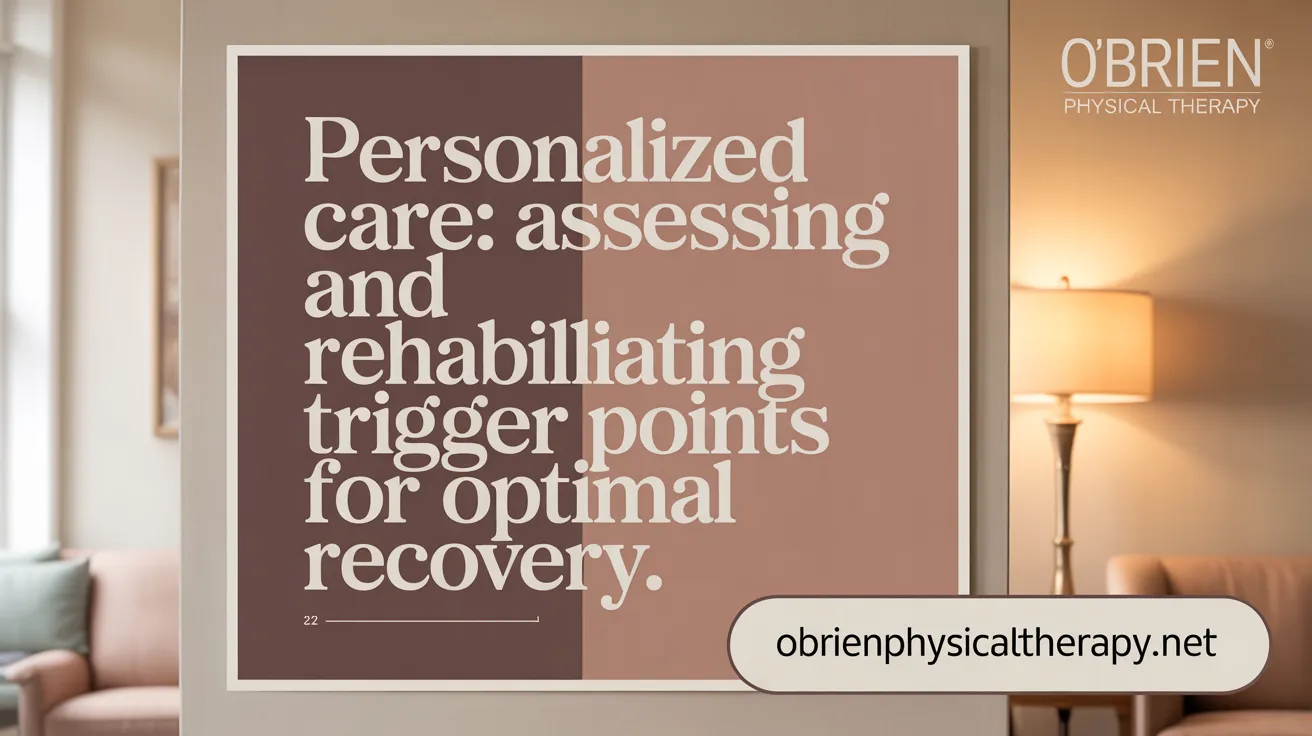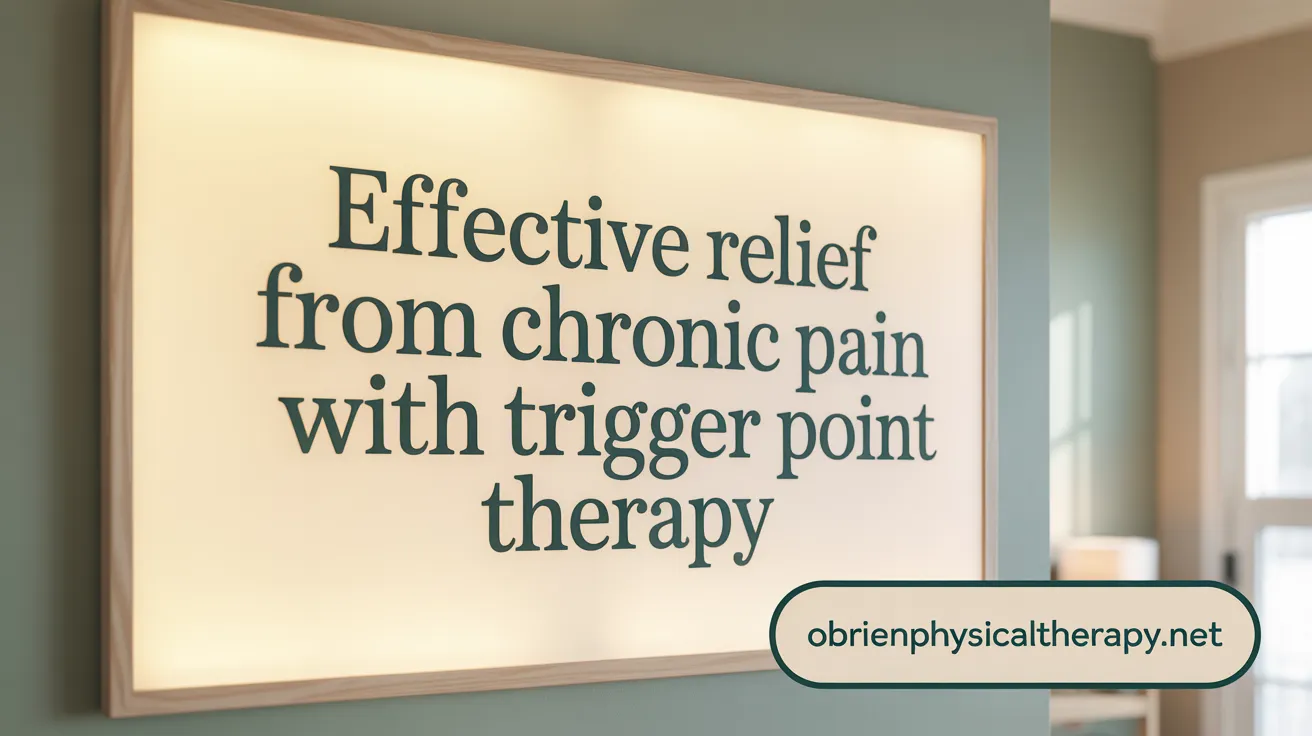What Is Trigger Point Therapy?
Understanding Trigger Points
Trigger points are small, hyperirritable knots found in muscle fibers or connective tissue. These muscle knots cause restricted blood flow and can become painful when pressed. They aren't just painful locally; they often cause referred pain, meaning pain felt in a different part of the body from the actual source.
How Trigger Points Affect the Body
Trigger points develop because of muscle overload from injuries, sustained postures, or repetitive movements. This muscle stress causes abnormal chemical activity that contracts fibers into tight knots. These knots trigger pain signals and can interfere with normal muscle function, often leading to stiffness, weakness, or limited movement.
Typical Symptoms and Problems
Common symptoms stemming from trigger points include localized pain, numbness, tingling, and even migraine headaches. For example, trigger points in the neck and shoulders may cause tingling sensations in the arms or hands, while those in the face can contribute to migraine headaches or jaw pain. Identifying and treating these trigger points is vital for relieving pain and restoring normal muscle function.
Mechanisms Behind Trigger Points and Their Impact on Muscle Function

How do trigger points form and affect the body?
Trigger points are localized areas of muscle fiber spasms or knots that develop due to acute, sustained, or repetitive muscle overload. This muscle overload triggers an abnormal release of acetylcholine, which leads to calcium influx into muscle cells and sarcomere contraction, resulting in tight, painful contraction knots (Muscle overload causing trigger points).
Physiology of trigger points
These hyperirritable spots restrict blood flow within the affected muscle tissue, causing tenderness and the potential for pain that extends beyond the actual site. This phenomenon is known as referred pain patterns from trigger points, where trigger points in one muscle can create symptoms in seemingly unrelated areas, such as numbness or tingling in the arm originating from neck or shoulder trigger points (Trigger points and referred pain, Arm numbness and tingling).
Formation due to muscle overload
Muscle overload can occur in various situations including occupational tasks, sports activities, or poor posture. Repetitive or sustained muscle use without adequate rest leads to the development of these contraction knots (Causes of trigger points.
Referred pain patterns and muscle spasms
Trigger points may not only cause local pain but also contribute to dysfunction in muscle performance and create referral pain patterns. Muscle spasms caused by these knots further limit normal tissue length and flexibility, exacerbating discomfort and restricting movement (Trigger points in pain conditions.
Addressing trigger points through controlled pressure techniques such as myofascial release technique in therapy can help release these knots, promote blood flow, and restore normal muscle function, ultimately reducing pain and improving mobility (Trigger point therapy treatment, Applying digital pressure to release trigger points.
Clinical Assessment and Personalized Rehabilitation in Treating Trigger Points

What does the initial patient evaluation involve?
The initial patient evaluation at the clinic is a thorough process that begins with discussing the patient's pain experience. Therapists assess posture and gait meticulously to uncover any musculoskeletal imbalances that may have led to the development of trigger points. This step is vital to identifying both the location and potential causes of muscle knots that contribute to pain and dysfunction.
How does posture and gait assessment support treatment?
Poor posture and abnormal gait patterns often place uneven stress on muscles, leading to localized muscle spasms known as trigger points. By analyzing these factors, clinicians can link trigger points to their underlying biomechanical causes. This assessment helps in creating targeted treatment plans that not only address pain but also correct the movement patterns contributing to muscle overload.
What are tailored treatment plans at the clinic?
Treatment begins with gentle manual therapies such as myofascial release technique and Swedish strokes, progressing carefully to trigger point therapy to ensure patient comfort. Therapists apply controlled, static pressure to release muscle knots without causing excessive discomfort. The treatment strategy integrates therapeutic exercises, daily activity training, and education about body mechanics. This personalized approach aims to retrain muscle memory, promote healing, and provide long-term pain relief.
What personalized rehabilitation services does the clinic offer?
The clinic offers individualized rehabilitation services starting with a comprehensive assessment of pain, strength, endurance, balance, and daily activities. Posture and gait analyses enable precise identification of trigger points related to musculoskeletal imbalances. Therapists then develop customized programs that may include exercise therapy, functional mobility training, and assistive device recommendations. This evidence-based rehabilitation ensures effective recovery by addressing both symptoms and underlying causes to restore active, pain-free living, including services in postpartum pelvic health rehabilitation.
Evidence-Based Techniques and Holistic Approaches to Trigger Point Therapy

What holistic health services are available at the clinic?
The clinic offers a comprehensive range of holistic health services designed to address the root causes of pain. These include dry needling, manual therapy, movement training, and Frequency Specific Microcurrent. Each treatment is delivered in personalized, one-on-one sessions by licensed Doctor of Physical Therapy professionals. This tailored approach supports effective management of common conditions such as back pain, sciatica, and neck or shoulder discomfort, while also promoting recovery after surgery with fewer visits and sustained improvements.
What evidence-based treatments does the clinic utilize?
Treatment methods at the clinic combine manual therapy techniques like joint mobilizations and soft tissue work, which have strong research backing for reducing pain and improving mobility. Neuromuscular electrical stimulation and carefully prescribed therapeutic exercise programs complement these hands-on therapies to enhance patient outcomes. Clinicians integrate patient education to empower individuals to maintain long-term health and prevent recurrence. Special attention is given to postpartum pelvic health rehabilitation, ensuring specialized, evidence-supported care.
How are gentle treatment methods like myofascial release and Swedish strokes integrated?
Therapists begin with gentle techniques such as myofascial release technique and Swedish strokes to prepare muscles and connective tissues. These methods help relax tight areas and increase circulation, creating an optimal condition for more targeted Trigger point therapy. The intention is to ensure comfort and avoid excessive pain during treatment.
What are the application and pressure techniques used in trigger point therapy?
During trigger point therapy, clinicians apply controlled static pressure to identified hyperirritable nodules in muscle or connective tissue. Pressure is maintained for 30 to 90 seconds while continuously monitoring the patient’s tolerance. This approach promotes release of muscle tissue knots by safely reducing spasms without causing guarding or significant discomfort. The goal is to elicit a manageable 'good hurt' sensation, facilitating retraining muscle memory and long-term pain relief.
This evidence-based, holistic strategy emphasizes individualized care, effectively addressing both localized referred pain patterns from trigger points and trigger points and referred pain patterns. Patients benefit from a supportive environment focused on active recovery and lasting wellness.
Applying Trigger Point Therapy: Techniques and Patient Experience

How Is Static Pressure Applied in Trigger Point Therapy?
Trigger point therapy involves applying steady, controlled static pressure directly to the affected muscle tissue knots. Therapists use digital pressure to release trigger points for a precise duration, typically between 30 to 90 seconds, to help release the muscle spasm and restore normal tissue length. This careful technique avoids provoking guarding reflexes or excessive muscle tension, allowing the targeted muscles to relax effectively.
Why Is Communication About Pain Tolerance Important?
Open communication between therapist and patient is essential throughout trigger point therapy. Since these spots can be sensitive, therapists continuously check in to gauge what level of pressure is tolerable. The goal is to elicit a ‘good hurt’ sensation—enough pressure to release tension without causing undue pain or discomfort. This patient-centered approach ensures safety and maximizes therapy benefits.
What Is the Treatment Progression for Trigger Point Therapy?
Treatment typically starts with gentle methods such as myofascial release techniques and Swedish massage strokes. These initial techniques warm up tissues and prepare muscles for targeted trigger point therapy treatment. As patient tolerance and muscle response improve, therapists gradually apply more focused pressure on specific trigger points to promote long-term pain relief and improved muscle function.
How Is Excessive Discomfort Avoided During Treatment?
Therapists use a controlled and measured approach to avoid causing excessive discomfort. By applying pressure in a series of measured doses and monitoring patient feedback, they can adjust intensity accordingly. The intention is to maintain therapeutic effectiveness while preventing pain that could cause muscle guarding, thus enhancing the overall patient experience and treatment outcomes. This approach aligns with managing client pain tolerance in massage and ensures effective, noninvasive treatment for muscle dysfunction.
Trigger Point Therapy for Common Pain Conditions and Long-Term Outcomes

What Conditions Respond Well to Trigger Point Therapy?
Trigger point therapy is effective for various pain conditions caused by muscle tissue knots or hyperirritable spots. Common issues include sciatica, frozen shoulder, low back pain, plantar fasciitis, and even trigger finger. Trigger points can cause local pain and refer discomfort to other areas, such as numbness or tingling in the arms when neck and shoulder trigger points are involved.
How Does Trigger Point Therapy Help Prevent Surgeries and Lower Costs?
By targeting underlying muscle spasms and abnormal tension, trigger point therapy promotes natural healing and long-term pain relief. This noninvasive treatment for muscle dysfunction often reduces the need for surgery and costly medical interventions. It offers a patient-centered alternative focused on long-term pain relief and reducing surgeries and medical costs.
Why Are Multiple Sessions Sometimes Needed in Chronic Cases?
Chronic pain conditions typically require a series of treatments. Each session works to progressively release trigger points and restore normal muscle length and function. Therapists use controlled static pressure application to avoid excessive discomfort while encouraging muscles to "reset" and break the pain cycle.
How Does Retraining Muscle Memory Contribute to Lasting Relief?
Trigger point therapy not only alleviates immediate pain but also helps retrain muscle memory. This process changes how muscles contract and stabilize over time, providing durable relief. Ongoing treatment helps prevent trigger points from recurring, making it a valuable preventative pain management tool for long-term wellness.
Clinical Specialties and the Role of Trigger Point Therapy in Comprehensive Care

What specialties does the clinic focus on?
The clinic specializes in women’s health, focusing on postpartum pelvic health rehabilitation, pelvic health, and hormonal wellness. It also provides sports rehabilitation to support athletes with injury recovery and enhance performance.
Trigger point therapy is seamlessly integrated into these specialties. Since women’s health and sports rehabilitation patients often experience muscular pain and dysfunction, trigger point therapy helps identify and treat painful muscle knots that contribute to their symptoms.
How is trigger point therapy integrated within these specialties?
Trigger point therapy complements other treatment methods by addressing the muscular component of pain directly. Therapists assess posture and gait assessment, then apply gentle, controlled pressure to release trigger points, relieving pain and improving function. This approach benefits postpartum recovery by addressing pelvic muscle tension and supports athletes by speeding rehabilitation and reducing re-injury risk.
What is the overall impact on pain management and wellness?
Incorporating trigger point therapy promotes long-term pain relief by retraining muscle memory and reducing nerve irritation. This can lower the need for invasive procedures and improve quality of life. Patients often experience decreased pain, improved mobility, and greater participation in wellness activities, empowering them toward active, pain-free living.
The Value of Trigger Point Therapy in a Holistic Rehabilitation Framework
Understanding the Benefits of Trigger Point Therapy
Trigger point therapy targets hyperirritable knots in muscles and connective tissues that limit blood flow and cause pain. By addressing these points, patients often experience relief from both localized pain and referred symptoms, such as numbness or tingling in the arms or migraines.
A Personalized, Holistic Approach
At clinics like Northwestern Health Sciences, treatment begins with a comprehensive assessment including pain discussion, posture, and gait analysis. Therapy progresses from gentle techniques to more focused trigger point therapy, designed to avoid excessive discomfort while promoting muscle memory retraining for long-term pain relief.
Encouragement for Professional Guidance
Given the complexity of trigger points and their effects, individualized professional assessment and treatment are essential. This noninvasive therapy can reduce reliance on surgery and medication, improving overall wellness through safe, gradual intervention tailored to each patient’s needs.
